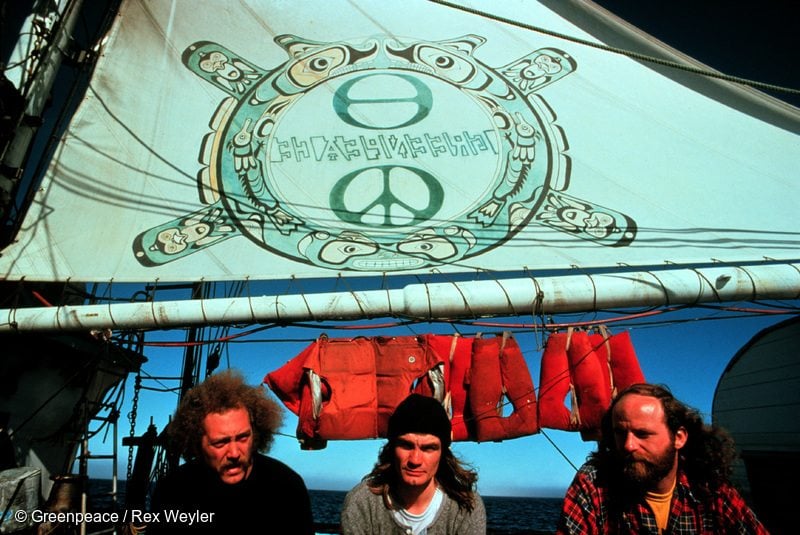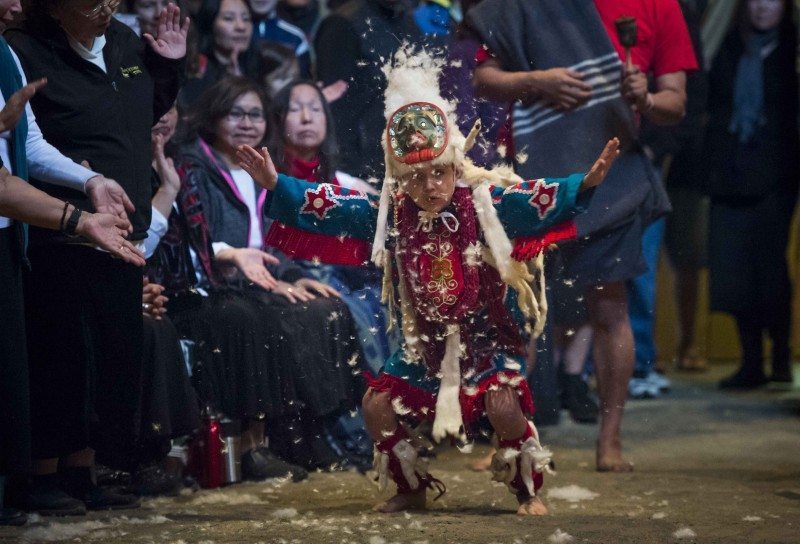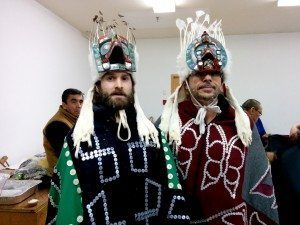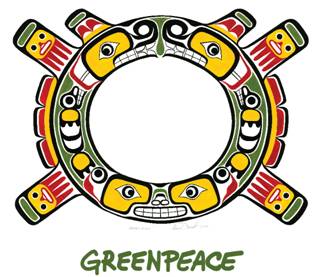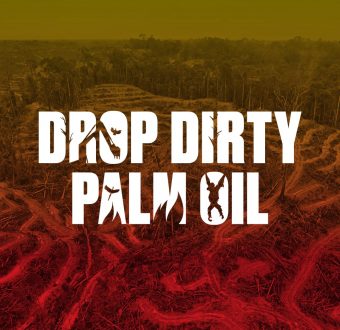Editor’s note: read an abbreviated version of this history here.
A few months ago I had the privilege to of watching an advance screening of the extraordinary documentary on Greenpeace’s early history, “How to Save the World.” Jerry Rothwell’s compelling film brings to life an important and formative chapter of how Greenpeace began and where its roots lie, as seen through the eyes of late co-founder Bob Hunter.
The film is rich with passionate people who founded this intrepid organization, and overall I felt a sense of pride being connected through my work as a forest campaigner to the incredible legacy left by such a small but powerful and dedicated group of women and men.
However there was one image seen throughout the film that brought both a knowing smile and a slight wince to my face — that of the old Greenpeace ecology and peace logo encircled by a double-headed serpent.
Many times seen emblazoned on Greenpeace ships, windows, and other materials, the image is in fact an altered, hybridized version of an ancient crest called the Sisiutl. The crest is sacred to (amongst others) the indigenous Kwakwaka’wakw, Heiltsuk, and Nuu-cha-nulth peoples of the Pacific Northwest.
How this symbol came to appear prominently on the sail of the first Greenpeace ship, Phyllis Cormack, and continues to be part of the Greenpeace brand is an intimate and intrinsic part of Greenpeace’s origin story. It is also a story of cultural appropriation. And my job for the past year has been managing the Sisiutl Renewal Project, with the goal of both restoring the dignity of the crest at Greenpeace and the spirit with which it was shared with us.
The Sisiutl Renewal Project is one small but important step towards decolonizing our organization. Other steps include policies recently developed by Greenpeace USA and Greenpeace Canada addressing how each will reconcile and work with indigenous peoples.
Back to the Beginning
But let’s go back to 1971, to Greenpeace’s very origins. The organization’s first mission was protesting U.S. nuclear testing at Amchitka, Alaska. To do this, a small ground of activists chartered a fishing vessel, the Phyllis Cormack, to sail out to the front lines of nuclear testing.
Along the way, it stopped at the indigenous community of Alert Bay (or ‘Yalis – its actual Kwakwaka’wakw name) on Cormorant Island, located on Canada’s west coast. Here, members of the Kwakwaka’wakw group of First Nations gifted the crew (which included Greenpeace founder Bob Hunter) with wild coho salmon and a blessing for their journey. This also happened to be the young organization’s first interaction with an indigenous community.
As they continued on to Amchitka, the U.S. Coast Guard prevented the Greenpeace crew from confronting the nuclear weapons test, and with deflated spirits they reluctantly headed back to Vancouver, British Columbia. En route, the Phyllis Cormack stopped once again in Alert Bay, where the crew was invited to a celebration in their honor at their ceremonial Big House.
They were acknowledged by members of the ‘Namgis First Nation and other Kwakwaka’wakw communities for their courage in standing up to the Unites States military industrial complex with a special ceremony that included song, dance and food. The crew had Kwakwaka’wakw traditional regalia placed on them, with eagle down on their heads, and even participated in one of the ceremonial dances — the Peace Dance. It was a great honor. Bob writes in his memoir Warriors of the Rainbow that the crew was “made into brothers of the [Kwakwaka’wakw] people,” or in other words, they were ceremonially adopted by the community. All of this lifted their spirits.
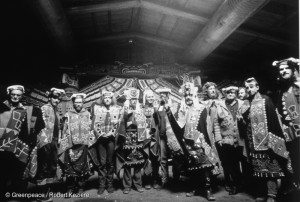
Greenpeace voyagers in full regalia at Alert Bay following the first Greenpeace voyage to Amchitka. Photo by Greenpeace / Rex Wyler.
Shortly after that important ceremony Bob was given a blue cloth with a Sisiutl crest by a Kwakwaka’wakw community member.
Greenpeace and the Sisiutl
The Sisiutl symbol is a powerful spiritual crest originating with the Kwakwaka’wakw. It is a supernatural creature with two heads, one at each end and a human head in the middle, which for the Kwakwaka’wakw symbolizes the balance of life between good and evil. Wearing it and telling its stories helps warriors and healers with their work. It is also used to protect canoes and Big Houses.
Only certain Kwakwaka’wakw individuals and families, as well as other coastal First Nations, have the cultural and spiritual rights to display the Sisiutl in ceremonies. To have the Sisiutl shared with Bob and Greenpeace was a huge honor.
We don’t actually know at this point what the original Sisiutl on that piece of cloth looked like or why it was shared with Bob. We can only surmise that given its meanings of protection and general association with the sea and warriors that it was a blessing or gift intended to help the Greenpeace team succeed in its important work after the Amchitka campaign.
What we do know is that its form was dramatically altered sometime between 1974 and 1975, when Bob and other Greenpeace members decided to use it as the basis for a new symbol for their anti-commercial whaling campaign that was to launch in 1975. Bob wrote in Warriors of the Rainbow that he believed Greenpeace had permission to adapt the crest because the original crew had been adopted into the Kwakwaka’wakw during the 1971 ceremony.
In “How to Change the World,” you can see rare footage of the altered Sisiutl/Greenpeace symbol being painted for the first time on the ship’s sail , and then subsequently worn as t-shirts by Greenpeace volunteers and staff, on office walls, and more.
In making that fateful decision to adopt and adapt the Sisiutl as Greenpeace’s own, the sacred crest was in fact inappropriately altered and hybridized, its meaning forever changed. With the benefit of hindsight, and with greater understanding today of Kwakwaka’wakw customs and traditions, we believe that while the Sisiutl symbol itself was shared with Greenpeace, we didn’t have the right to alter it and make it our own — especially to the degree that this hybrid continues to be displayed in Greenpeace offices around the world (with incorrect stories tied to it).
Restoring the Sisiutl
With this in mind, Greenpeace Canada with support from Greenpeace International approached representatives of Kwakwaka’wakw communities to inquire about redesigning or restoring the Sisiutl to a more culturally appropriate form, and to explore the possibility of having it re-dedicated by representatives of these First Nations in the most meaningful and culturally appropriate way.
One representative suggested we commission well-known Kwakwaka’wakw artist and cultural leader Beau Dick to help us with this important task. Beau agreed to redesign the Sisiutl Crest for our use in perpetuity with our written promise to never alter it again.
Following protocol, we committed to a re-dedication ceremony at a potlatch that also renewed ties with the Kwakwaka’wakw. We again returned to Alert Bay in March 2015, where we had the honor and privilege of having the Sisiutl renewal ceremony take place at the Big House, at a potlatch hosted by an important hereditary family (see family representative Mike Willie’s blog for more of the story). A few of the community members present at the 1971 ceremony as youngsters were also there that day to bear witness to what took place.
Greenpeace International Executive Director Kumi Naidoo and Greenpeace Canada Executive Director Joanna Kerr, along with staff, joined surviving members of the original crew and Mike Willie on the potlatch floor for the special ceremony. Kumi and Joanna addressed the many hereditary chiefs and members of Alert Bay and surrounding communities, and apologized for the misuse and misappropriation of the original Sisiutl crest. Beau’s redesign of the Sisiutl rest was then revealed, and the historic occasion witnessed by all.
Later that night, Mark Worthing (who originally brought the altered Sisiutl/Greenpeace symbol to our attention and was crucial to the renewal project) and myself were taken to the back area of the Big House. We had traditional regalia placed on us, eagle down on the top of our heads (shown left), and were given a quick lesson on how to dance the Peace Dance before being ushered, with several community members, onto the potlatch floor.
Barbara Stowe — daughter of Greenpeace co-founders Irving and Dorothy Stowe — later said to me, “that was one of the most resonant and moving experiences of my life. The honor accorded to you and Mark was obvious, and through you this community had just accorded enormous respect and honor to Greenpeace.”
That moment, in echoing that historic day in the fall of 1971 when the crew of the Phyllis Cormack was also asked to dance the Peace Dance in full regalia, also helped reinvigorate the direct and emotional ties between our Greenpeace community and the Kwakwaka’wakw. We once again have become interconnected deeply and ceremonially with the Kwakwaka’wakw.
In addition, a few months later the Sisiutl Crest was re-introduced to the fleet of Greenpeace ships through a commemorative event on the Greenpeace vessel Esperanza in the Squamish First Nation traditional territory of North Vancouver, British Columbia. There, First Nations representatives from Squamish and Kwakwaka’wakw communities welcomed the ship, with Beau Dick and his group in full regalia formally blessing and presenting the renewed Sisiutl crest, in the form of a flag, to ship’s Captain Pep Barpal. The flag with the new Sisiutl Crest and the Greenpeace logo placed beside it was then hoisted to fly proudly alongside the international Greenpeace flag.
As a result, the renewed Sisiutl has now been brought back in a culturally appropriate form to the Greenpeace fleet, sanctioned through the sacred ceremony on the Esperanza.
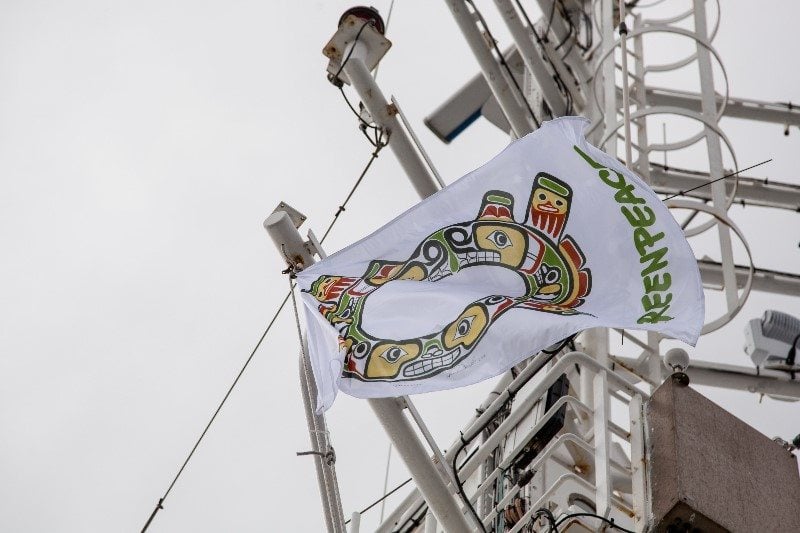
The renewed Sisiutl Crest flies proudly alongside international Greenpeace and Haida Nation flags on the Esperanza ship. © Joseph Strohan / Greenpeace.
Rewriting Our Story
“How to Change the World” is an important film in that it demonstrates how a small group of impassioned individuals can make a difference in the world. It also authentically reveals all-too human frailties. These frailties also underscore what happened with the Sisiutl — in the desire to do good in the world, ego-driven decisions can lead to mistakes that leave lasting legacies.
We acknowledge the heroics of those incredible people involved in the heady days of Greenpeace’s origins and in the case of the Sisiutl, we must now also take responsibility for the legacy of its cultural appropriation. Aside from following proper protocols and undertaking ceremonies that now authorize us to carry the new Sisiutl, we are rewriting the story of how we came to the symbol and what it actually means, and will circulate it — along with prints of Beau’s Sisiutl — to Greenpeace offices around the world.
Managing the Sisutl Renewal Project has a been deeply meaningful journey not only towards helping the organization decolonize a symbol intertwined with its identity, but also towards decolonizing my own mind and thinking processes. It has also been a great metaphor for a mind bomb. Bob would be proud.
